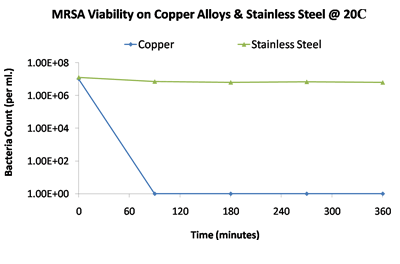As a constant culprit to patient safety and infection control in healthcare environments, prevention of MRSA infections is an increasing goal in healthcare facilities worldwide.

Multi-drug resistant strains of this bacterium are easily transferred from patients and healthcare workers to touched surfaces and vice versa. Laboratory testing has proven that Antimicrobial Copper touch surfaces deliver continuous and ongoing antibacterial action against MRSA.
By constructing the hospital built environment out of hygienic and bacteria killing materials, a facility can greatly reduce their bio-load.
Organizations like MRSA Survivors Network and MRSAid are leading advocates for improved patient safety against MRSA infections.

The graph above illustrates the survival of MRSA on Antimicrobial Copper and stainless steel for comparison. As mentioned above, many copper alloys can legally claim a 99.9% kill of MRSA within two hours.
Read more on the other bacteria that Antimicrobial Copper is registered to kill.
- E. coli O157:H7
- VRE : Vancomycin-Resistant Enterococcus faecalis
- Enterobacter aerogenes
- Pseudomonas aeruginosa

*Laboratory testing shows that, when cleaned regularly, antimicrobial copper surfaces kill greater than 99.9% of the following bacteria within 2 hours of exposure: MRSA, VRE, Staphylococcus aureus, Enterobacter aerogenes, Pseudomonas aeruginosa, and E. coli O157:H7. Antimicrobial copper surfaces are a supplement to and not a substitute for standard infection control practices and have been shown to reduce microbial contamination, but do not necessarily prevent cross contamination or infections; users must continue to follow all current infection control practices.

